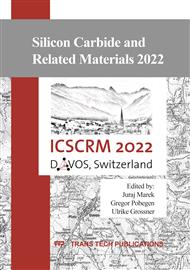[1]
P. Bergveld, "The future of biosensors," Sens Actuators A Phys, vol. 56, no. 1–2, p.65–73, 1996.
DOI: 10.1016/0924-4247(96)01275-7
Google Scholar
[2]
D. P. Tran, T. T. T. Pham, B. Wolfrum, A. Offenhäusser, and B. Thierry, "CMOS-compatible silicon nanowire field-effect transistor biosensor: Technology development toward commercialization," Materials, vol. 11, no. 5, 2018.
DOI: 10.3390/ma11050785
Google Scholar
[3]
P. Ambhorkar et al., "Nanowire-based biosensors: From growth to applications," Micromachines (Basel), vol. 9, no. 12, p.1–19, 2018.
DOI: 10.3390/mi9120679
Google Scholar
[4]
S. Sang, Y. Wang, Q. Feng, Y. Wei, J. Ji, and W. Zhang, "Progress of new label-free techniques for biosensors: A review," Crit Rev Biotechnol, vol. 36, no. 3, p.465–481, 2016.
DOI: 10.3109/07388551.2014.991270
Google Scholar
[5]
M. Y. Shen, B. R. Li, and Y. K. Li, "Silicon nanowire field-effect-transistor based biosensors: From sensitive to ultra-sensitive," Biosens Bioelectron, vol. 60, p.101–111, 2014.
DOI: 10.1016/j.bios.2014.03.057
Google Scholar
[6]
F. R. R. Teles and L. P. Fonseca, "Trends in DNA biosensors," Talanta, vol. 77, no. 2, p.606–623, 2008.
DOI: 10.1016/j.talanta.2008.07.024
Google Scholar
[7]
P.Bergveld, "Thirty years of ISFETOLOGY," Sensors and Actuators B, no. 2003, p.1–20, 2003.
DOI: 10.1016/s0925-4005(02)00301-5
Google Scholar
[8]
Peter Fromherz, The Neuron-semiconductor Interface, Bioelectronics. Weinheim.
Google Scholar
[9]
R. Bange et al., "Chemical stability of Si-SiC nanostructures under physiological conditions," in Materials Science Forum, 2017, vol. 897 MSF, p.638–641.
DOI: 10.4028/www.scientific.net/MSF.897.638
Google Scholar
[10]
E. Bano, L. Fradetal, V. Stambouli, and G. Attolini, "DNA detection using SiC nanowire based transistor," Materials Science Forum, vol. 858, p.1006–1009, 2016.
DOI: 10.4028/www.scientific.net/MSF.858.1006
Google Scholar
[11]
S. E. Saddowl et al., "3C-SiC on Si : A Bio- and Hemo-compatible Material for Advanced Nano-Bio Devices," p.49–53.
Google Scholar
[12]
O. Karker et al., "Modelling and Development of 4H-SiC Nanowire/Nanoribbon Biosensing FET Structures," Materials Science Forum, vol. 1062, p.608–612, May 2022.
DOI: 10.4028/p-23d7ab
Google Scholar
[13]
O. Knopfmacher et al., "Nernst limit in dual-gated Si-nanowire FET sensors," Nano Lett, vol. 10, no. 6, p.2268–2274, Jun. 2010.
DOI: 10.1021/nl100892y
Google Scholar
[14]
I. M. Datye, A. J. Gabourie, C. D. English, N. C. Wang, and E. Pop, "Reduction of Hysteresis in MoS2 Transistors Using Pulsed Voltage Measurements," 2014.
DOI: 10.1109/drc.2016.7548426
Google Scholar



